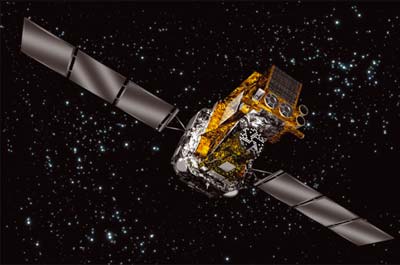
Positron annihilation detected by INTEGRAL, the gamma-ray observatory launched in October 2002, is probably not of dark-matter origin.
Image credit: ESA.
A new study on the propagation of positrons in the galaxy suggests that dark-matter annihilation or decay is not required to account for gamma-ray observations by ESA’s INTEGRAL satellite. It shows that the observed characteristics of the positron emission can be fully accounted for by β+ decay of radionuclei produced by nucleosynthesis in supernova explosions and the wind of massive stars.
One of the main successes of the INTEGRAL gamma-ray satellite is its unprecedented characterization and mapping of positron annihilation in the galaxy. Early results from INTEGRAL’s spectrometer showed that the 511 keV emission line from electron–positron annihilation is mainly emitted from a circular region that corresponds roughly to the central bulge of the Milky Way. As the galactic-disc emission could not be clearly detected, the data implied a bulge-to-disc ratio at least three times higher than for the production sites of positrons by β+ decay in supernova ejecta.
Dark matter soon emerged as an explanation for the positron excess in the bulge compared with the distribution in supernovae of type Ia (CERN Courier November 2004 p13). Researchers then realized, however, that the range of masses for the required lightweight dark-matter particle was severely limited by the deduced maximum energy of the positrons (CERN Courier December 2006 p14). Nevertheless, over recent years, more than 100 papers have been published on exotic dark-matter candidates that could explain the positron excess in the galactic bulge. These include new axions, superconducting strings, Q balls, sterile neutrinos, millicharged fermions, unstable branons and many more.
This proliferation of exotic ideas should stop with the recent publication of a paper in Physical Review Letters by Richard Lingenfelter and Richard Rothschild from the University of California San Diego and their colleague James Higdon at the Keck Science Center. Their letter is based on a detailed study that they published in the Astrophysical Journal, where they demonstrate that the assumption that positrons cannot propagate over large distances in the galaxy is wrong. They further show that positrons from the decay of the radionuclei 56Ni, 44Ti and 26Al produced in supernova ejecta will preferably decay in the denser environment of the galactic bulge, where most of the molecular clouds are concentrated.
Lingenfelter and colleagues therefore argue that the observed bulge excess can be fully accounted for by identified astrophysical sources of positrons, mainly the supernova ejecta and the strong winds of massive stars. The easy propagation of the positrons before annihilation in the dense envelopes of molecular clouds also explains the high positronium fraction (94% ± 4%) deduced from the ratio of the 511 keV line flux to the three-photon continuum emission at lower energies. The study further suggests that the observed asymmetry of the positron annihilation between one side of the galactic plane and the other (CERN Courier March 2008 p12) could just result from the asymmetric distribution of the inner spiral arms of the galaxy as seen from the Earth.
In view of these results, it seems that the excitement about a possible dark-matter signal in the INTEGRAL measurements was premature and built on shaky ground. With the recent arguments against other dark-matter claims, this elusive matter looks even darker than ever (Cosmic leptons challenge dark-matter detection).







